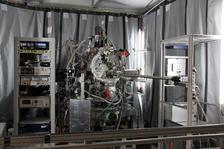Schematics of the HEXTOF instrument
The HEXTOF (High Energy X-ray Time-Of-Flight) instrument is a versatile setup for space-, time- and spin-resolved photoemission spectroscopy using a time-of-flight momentum microscope.
Photoemission spectroscopy (PES) is a powerful technique, which allows investigating the electronic properties of solid systems and molecules. When used in combination with high repetition rate free electron lasers in the XUV and soft X-ray regime such as FLASH (DESY, Hamburg) or with the table-top laser systems based on the high harmonic generation (HHG) it has a high potential for time-resolved PES. The possibility to use both X-ray and laser pulses with time duration of few tens of femtoseconds will allow to access ultrafast electronic phenomena, lattice dynamics and chemical reactions. The photo-emitted electrons carry all the information regarding the electronic states of the system in the photo-generated non-equilibrium state. To fully exploit this information, it is necessary to use very efficient detection schemes for the photoelectrons, such as a time-of-flight momentum microscope. The momentum microscope allows simultaneous detection of the entire band structure with unprecedented efficiency in the full surface Brillouin zone with up to 8 Å-1 diameter and several eV binding energy range, resolving about 2.5x105 voxels, or the angular pattern of core level photoelectrons, respectively, for each time step in a pump-probe experiment. The novel experimental approach envisioned here combines time- and momentum-resolved photoelectron, parallel spin detection, x-ray photoelectron spectroscopy (XPS), and x-ray photoelectron diffraction (XPD) into a single experiment and can directly probe and disentangle the fundamental interactions behind these different emergent properties.
|
Target Beamlines |
Flexible, particular at PG2 (FL14) and FL23 |
|---|---|
|
Sample environment |
UHV, 10-10 mbar |
|
Sample type |
Solid state, Omicron (flag) type sample holder, max. 10x10x1 mm |
|
Sample temperature |
25K to 450K |
|
Spectrometer Energy Resolution |
70 – 100 meV (straight branch) |
|
Spectrometer Momentum resolution |
0.06Å-1 (straight branch) |
|
Detector |
8-segment delay-line detector (DLD), Surface Concept GmbH |
|
Technique |
trARPES, trMOM, trXPS, trXPD, tr-Spin-ARPES (optional) |
|
Preparation chamber |
LEED, high-temperature annealing and flash, Ar sputtering, load-lock, gas dosing system, sample storage, quartz monitor, free ports for evaporators or vacuum suit case |
References:
[1] Instrument design and commissioning at FLASH/PG2 beamline:
D. Kutnyakhov et al., “Time- and momentum-resolved photoemission studies using time-of-flight momentum microscopy at a free-electron laser”, Rev. Sci. Instrum. 91, 013109 (2020), https://doi.org/10.1063/1.5118777
[2] Instrument design and commissioning at HHG laboratory source:
M. Heber, N. Wind, et al., “Multispectral time-resolved energy–momentum microscopy using high-harmonic extreme ultraviolet radiation”, Rev. Sci. Instrum. 93, 083905 (2022), https://doi.org/10.1063/5.0091003
[3] Typical data analysis workflow:
R. P. Xian, D. Kutnyakhov et al., “An open-source, end-to-end workflow for multidimensional photoemission spectroscopy”, Sci Data 7, 442 (2020), https://doi.org/10.1038/s41597-020-00769-8
[4] Analysis software (sed-processor) for multidimensional single-event datastreams and example tutorials available at https://github.com/OpenCOMPES/sed







